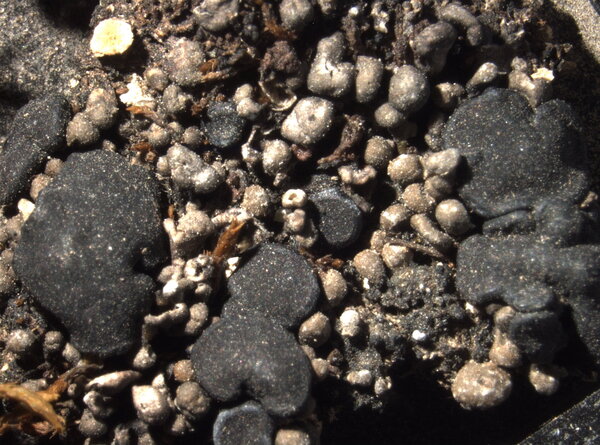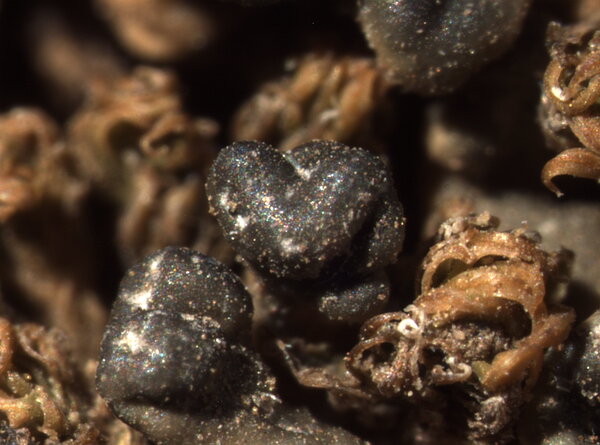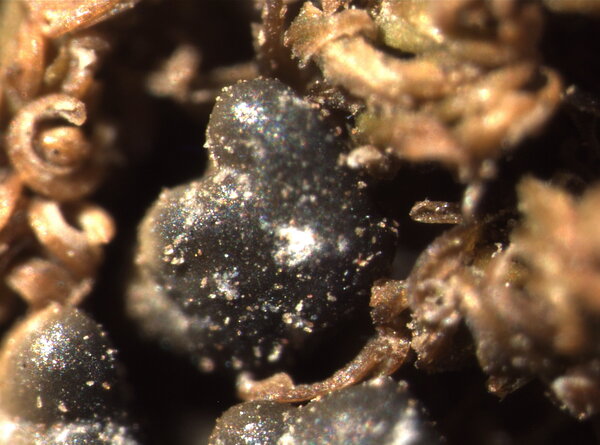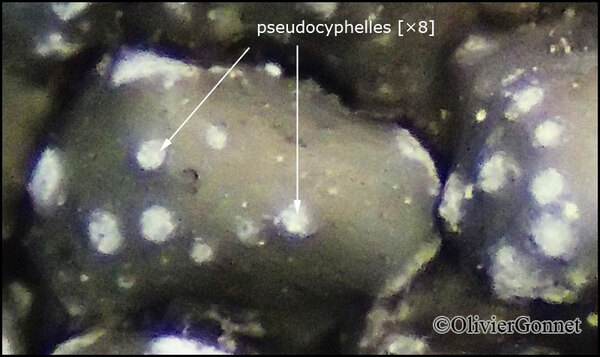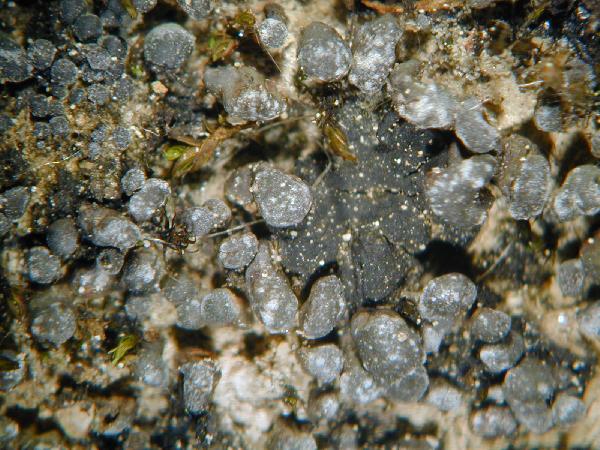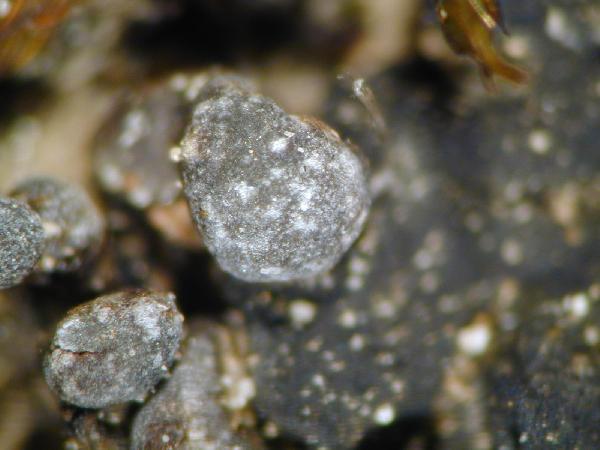Thalloidima physaroides (Opiz) Kistenich, Timdal, Bendiksby & S.Ekman
Taxon, 67: 897, 2018.. Basionym: Lecidea physaroides Opiz - Lotos, 6: 158, 1856.
Synonyms: Bacillina antipolitana Nyl.; Biatorina lurida (Bagl. ex Arnold) Jatta; Thalloidima luridum Bagl. ex Arnold; Toninia alluviicola M. Choisy; Toninia lurida (Bagl. ex Arnold) H. Olivier; Toninia physaroides (Opiz) Zahlbr.
Description: Thallus squamulose to subfruticose, the squamules 1-2(-3) mm broad, to several mm long, scattered to usually contiguous and forming cushions, convex and bullate when young, then often becoming elongate and columnar, simple or branched above, dark grey to dark greyish green, weakly pruinose to epruinose, with numerous, punctiform to slightly elongated, white pseudocyphellae. Upper cortex 15-50 µm thick, including an up 20 µm thick epinecral layer (often thin or absent); algal layer continuous; medulla white, lacking crystals. Apothecia very rare, lecideine, rounded, sessile, strongly constricted at base, up to 6(-8) mm across, with a black, faintly pruinose to usually epruinose, flat to convex, smooth disc, and a distinct, smooth, concolorous proper margin. Proper exciple dark grey in outer part, pale grey to colourless within, the pigmented parts K+ and N+ violet; epithecium grey, K+ and N+ violet; hymenium colourless, 60-70 µm high; paraphyses coherent, simple or sparingly branched and anastomosing in upper part, thin-walled, the apical cell distinctly swollen and covered by a gelatinous pigment cap; hypothecium pale brown to colourless. Asci 8-spored, clavate, surrounded by a gelatinous I+ blue coat, with a well-developed I+ blue tholus with a I+ darker blue tube and a well-developed ocular chamber, Bacidia-type. Ascospores 1-septate, hyaline, fusiform, 11-19 x 3.5-5 µm. Photobiont chlorococcoid. Spot tests: thallus K-, C-, KC-, P-, UV-. Chemistry: thallus without lichen substances or with traces of fatty acids; Sedifolia-grey pigment in apothecia.
Growth form: Squamulose
Substrata: soil, terricolous mosses, and plant debris
Photobiont: green algae other than Trentepohlia
Reproductive strategy: mainly sexual
Subcontinental: restricted to areas with a dry-subcontinental climate (e.g. dry Alpine valleys, parts of Mediterranean Italy)
Commonnes-rarity: (info)
Alpine belt: absent
Subalpine belt: extremely rare
Montane belt: very rare
Dry submediterranean belt: very rare
Humid submediterranean belt: extremely rare
Padanian area: absent
pH of the substrata:
1 2 3 4 5
Solar irradiation:
1 2 3 4 5
Aridity:
1 2 3 4 5
Eutrophication:
1 2 3 4 5
Poleotolerance:
0 1 2 3
Altitudinal distribution:
1 2 3 4 5 6
Rarity
absent
extremely rare
very rare
rare
rather rare
rather common
common
very common
extremely common
Loading data...
Occurrence data
Predictive map
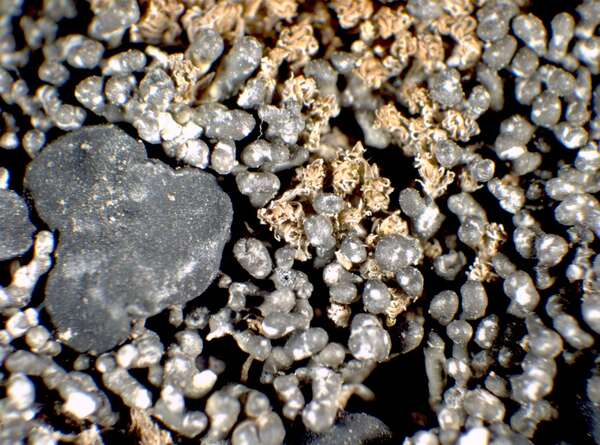
P.L. Nimis; Owner: Department of Life Sciences, University of Trieste
Herbarium: TSB (14164)
2001/12/01

P.L. Nimis; Owner: Department of Life Sciences, University of Trieste
Herbarium: TSB (14164)
2001/12/01
detail of pseudocyphellae
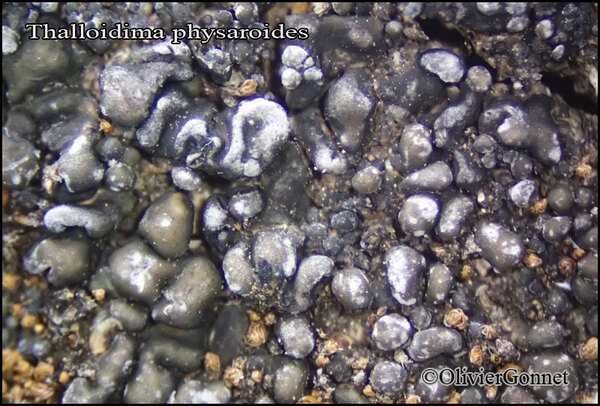
Courtesy Danièle et Olivier Gonnet - Source: https://www.afl-lichenologie.fr/Photos_AFL/Photos_AFL_T/Textes_T2/Thalloidima_physaroides.htm
France, sur sol calcaire - session AFL 2010 - Hérault
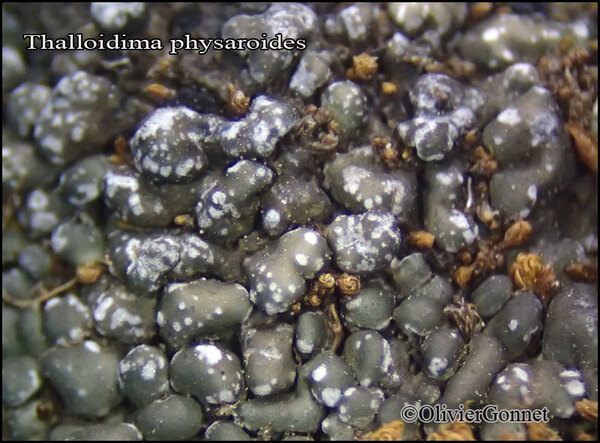
Courtesy Danièle et Olivier Gonnet - Source: https://www.afl-lichenologie.fr/Photos_AFL/Photos_AFL_T/Textes_T2/Thalloidima_physaroides.htm
France, sur sol calcaire - session AFL 2010 - Hérault
Growth form: Squamulose
Substrata: soil, terricolous mosses, and plant debris
Photobiont: green algae other than Trentepohlia
Reproductive strategy: mainly sexual
Subcontinental: restricted to areas with a dry-subcontinental climate (e.g. dry Alpine valleys, parts of Mediterranean Italy)
Commonnes-rarity: (info)
Alpine belt: absent
Subalpine belt: extremely rare
Montane belt: very rare
Dry submediterranean belt: very rare
Humid submediterranean belt: extremely rare
Padanian area: absent
pH of the substrata:
| 1 | 2 | 3 | 4 | 5 |
Solar irradiation:
| 1 | 2 | 3 | 4 | 5 |
Aridity:
| 1 | 2 | 3 | 4 | 5 |
Eutrophication:
| 1 | 2 | 3 | 4 | 5 |
Poleotolerance:
| 0 | 1 | 2 | 3 |
Altitudinal distribution:
| 1 | 2 | 3 | 4 | 5 | 6 |
Rarity
absent
extremely rare
very rare
rare
rather rare
rather common
common
very common
extremely common
Loading data...
Occurrence data
Predictive map

P.L. Nimis; Owner: Department of Life Sciences, University of Trieste
Herbarium: TSB (14164)
2001/12/01

P.L. Nimis; Owner: Department of Life Sciences, University of Trieste
Herbarium: TSB (14164)
2001/12/01
detail of pseudocyphellae

Courtesy Danièle et Olivier Gonnet - Source: https://www.afl-lichenologie.fr/Photos_AFL/Photos_AFL_T/Textes_T2/Thalloidima_physaroides.htm
France, sur sol calcaire - session AFL 2010 - Hérault



